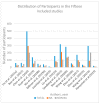Diagnostic Efficacy of Advanced Ultrasonography Imaging Techniques in Infants with Biliary Atresia (BA): A Systematic Review and Meta-Analysis
- PMID: 36360404
- PMCID: PMC9688715
- DOI: 10.3390/children9111676
Diagnostic Efficacy of Advanced Ultrasonography Imaging Techniques in Infants with Biliary Atresia (BA): A Systematic Review and Meta-Analysis
Abstract
The early diagnosis of biliary atresia (BA) in cholestatic infants is critical to the success of the treatment. Intraoperative cholangiography (IOC), an invasive imaging technique, is the current strategy for the diagnosis of BA. Ultrasonography has advanced over recent years and emerging techniques such as shear wave elastography (SWE) have the potential to improve BA diagnosis. This review sought to evaluate the diagnostic efficacy of advanced ultrasonography techniques in the diagnosis of BA. Six databases (CINAHL, Medline, PubMed, Google Scholar, Web of Science (core collection), and Embase) were searched for studies assessing the diagnostic performance of advanced ultrasonography techniques in differentiating BA from non-BA causes of infantile cholestasis. The meta-analysis was performed using Meta-DiSc 1.4 and Comprehensive Meta-analysis v3 software. Quality Assessment of Diagnostic Accuracy Studies tool version 2 (QUADAS-2) assessed the risk of bias. Fifteen studies consisting of 2185 patients (BA = 1105; non-BA = 1080) met the inclusion criteria. SWE was the only advanced ultrasonography technique reported and had a good pooled diagnostic performance (sensitivity = 83%; specificity = 77%; AUC = 0.896). Liver stiffness indicators were significantly higher in BA compared to non-BA patients (p < 0.000). SWE could be a useful tool in differentiating BA from non-BA causes of infantile cholestasis. Future studies to assess the utility of other advanced ultrasonography techniques are recommended.
Keywords: biliary atresia; diagnostic accuracy; diagnostic performance; elastography; intraoperative cholangiography (IOC); ultrasonography.
Conflict of interest statement
The authors declare no conflict of interest.
Figures












Similar articles
-
The utility of shear wave elastography and serum biomarkers for diagnosing biliary atresia and predicting clinical outcomes.Eur J Pediatr. 2022 Jan;181(1):73-82. doi: 10.1007/s00431-021-04176-y. Epub 2021 Jun 30. Eur J Pediatr. 2022. PMID: 34191129
-
Use of shear wave elastography for the diagnosis and follow-up of biliary atresia: A meta-analysis.World J Gastroenterol. 2022 Aug 28;28(32):4726-4740. doi: 10.3748/wjg.v28.i32.4726. World J Gastroenterol. 2022. PMID: 36157929 Free PMC article.
-
Ultrasound shear wave elastography: does it add value to gray-scale ultrasound imaging in differentiating biliary atresia from other causes of neonatal jaundice?Pediatr Radiol. 2021 Aug;51(9):1654-1666. doi: 10.1007/s00247-021-05024-9. Epub 2021 Mar 27. Pediatr Radiol. 2021. PMID: 33772640
-
Early differential diagnosis methods of biliary atresia: a meta-analysis.Pediatr Surg Int. 2018 Apr;34(4):363-380. doi: 10.1007/s00383-018-4229-1. Epub 2018 Feb 3. Pediatr Surg Int. 2018. PMID: 29397405 Review.
-
Is Diagnostic Performance of Quantitative 2D-Shear Wave Elastography Optimal for Clinical Classification of Benign and Malignant Thyroid Nodules?: A Systematic Review and Meta-analysis.Acad Radiol. 2022 Mar;29 Suppl 3:S114-S121. doi: 10.1016/j.acra.2017.09.002. Epub 2017 Oct 18. Acad Radiol. 2022. PMID: 29054676
Cited by
-
Improving the Outcome of Biliary Atresia: All Hands on Deck.Indian J Pediatr. 2024 Jul;91(7):649-650. doi: 10.1007/s12098-024-05102-4. Epub 2024 Mar 20. Indian J Pediatr. 2024. PMID: 38507130 No abstract available.
-
Performance of two-dimensional shear wave elastography for detecting advanced liver fibrosis and cirrhosis in patients with biliary atresia: a systematic review and meta-analysis.Pediatr Radiol. 2023 Dec;53(13):2642-2650. doi: 10.1007/s00247-023-05796-2. Epub 2023 Nov 2. Pediatr Radiol. 2023. PMID: 37917168
-
Combi-Elasto Evaluation of the Degree of Liver Fibrosis in Children with Cholestatic Liver Disease.Diagnostics (Basel). 2023 Oct 17;13(20):3229. doi: 10.3390/diagnostics13203229. Diagnostics (Basel). 2023. PMID: 37892048 Free PMC article.
-
Accurate prediction of biliary atresia with an integrated model using MMP-7 levels and bile acids.World J Pediatr. 2024 Aug;20(8):822-833. doi: 10.1007/s12519-023-00779-7. Epub 2023 Dec 23. World J Pediatr. 2024. PMID: 38141111 Free PMC article.
References
-
- Napolitano M. Imaging in biliary atresia. Pediatr. Radiol. 2019;49:S297. doi: 10.1007/s00247-019-04365-w. - DOI
Publication types
Grants and funding
LinkOut - more resources
Full Text Sources
Miscellaneous

